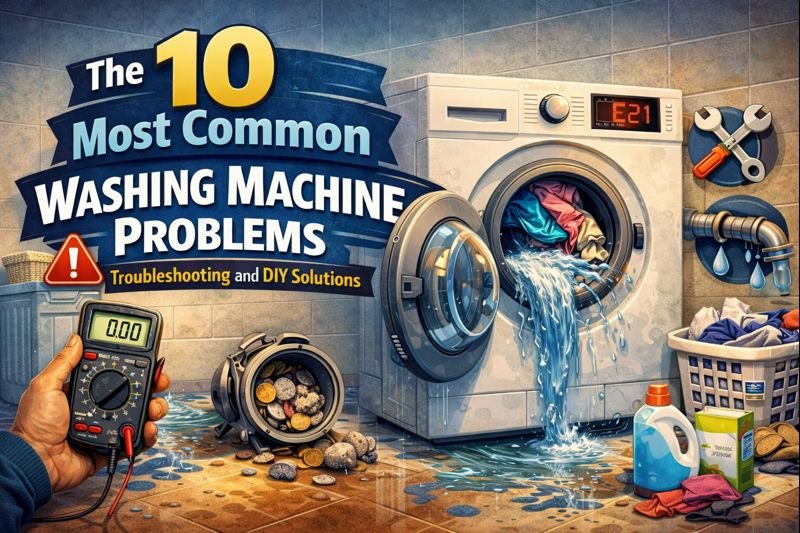
This guide covers the most common problems you might face with your washing machine, including causes, DIY solutions with estimated completion times, and when to call a technician. By following these tips, you can troubleshoot effectively and keep your machine running smoothly.
1. Washing Machine is Noisy
Common Causes:
- Loose objects (like coins)
- Unbalanced load
- Worn bearings
- Motor issues
DIY Solutions:
- Check Drum for Foreign Objects (10-15 minutes): Empty pockets and inspect the drum thoroughly. Remove any small items that might be causing noise.
- Redistribute Load (5 minutes): Balance heavy items to reduce noise. Adjusting the load may take a few minutes.
- Secure Loose Parts (10 minutes): Tighten screws and bolts. Ensure all components are properly secured.
When to Call a Technician:
- Persistent noise despite trying the above steps might indicate worn bearings or a malfunctioning motor. Contact a professional if you suspect these issues.
Parts That Might Be Needed:
- Drum bearings
- Suspension springs
- Motor
Preventative Tips:
- Always check pockets before washing.
- Regularly clean the drum and filters to prevent build-up.
Additional Tip: Regularly inspect the washing machine’s feet to ensure they are properly aligned and not causing vibrations.
2. Machine Doesn’t Spin
Common Causes:
- Overloaded machine
- Faulty motor
- Blocked drain
- Defective lid switch
DIY Solutions:
- Redistribute Load (5 minutes): Lighten the load and ensure even distribution.
- Check Lid Switch (5 minutes): Ensure the lid is properly closed. Test the switch with a multimeter if you have one.
- Inspect Drain Hose (10 minutes): Check for clogs that could affect spinning. Clean out any obstructions.
When to Call a Technician:
- If the motor is failing or if there are electrical issues.
Parts That Might Be Needed:
- Motor
- Lid switch
- Drive belt
Preventative Tips:
- Avoid overloading the washer.
- Perform regular checks on the drain hose and lid switch.
Additional Tip: Regularly inspect and clean the area around the lid switch to prevent dust and debris from causing issues.
3. Water Doesn’t Drain
Common Causes:
- Clogged drain hose
- Blocked filter
- Faulty drain pump
DIY Solutions:
- Clean the Drain Hose (10-15 minutes): Remove any blockages or kinks from the hose.
- Check and Clean the Filter (10 minutes): Regularly clear debris from the filter.
- Run a Spin/Drain Cycle (10 minutes): Helps to clear out any minor blockages.
When to Call a Technician:
- If cleaning doesn’t resolve the issue, the pump may need replacement.
Parts That Might Be Needed:
- Drain hose
- Drain pump
- Filter
Preventative Tips:
- Regularly clean filters and check hoses to prevent blockages.
Additional Tip: Run a monthly maintenance wash with hot water to help prevent clogs in the drainage system.
4. Washer Smells Bad
Common Causes:
- Mold or mildew build-up from frequent cold washes
- Liquid detergent residue
- Poor ventilation
DIY Solutions:
- Run a Hot Wash with Vinegar (30-40 minutes): Helps to kill mold and deodorize. Add 2 cups of white vinegar to the drum and run a hot cycle.
- Use a Washing Machine Cleaner (30 minutes): Designed to clean and freshen the drum. Follow the product instructions for best results.
- Leave the Door Open (Ongoing): Allowing air to circulate can prevent odors.
When to Call a Technician:
- Rarely needed unless there’s severe mold that can’t be removed with cleaning.
Parts That Might Be Needed:
- None typically required.
Preventative Tips:
- Use hot water cycles periodically and keep the door open when not in use.
Additional Tip: Regularly clean the gasket around the door as it can trap moisture and lead to odors.
5. Washing Machine Leaks
Common Causes:
- Loose hoses
- Worn-out door seals
- Issues with the detergent drawer
DIY Solutions:
- Tighten Hoses (5-10 minutes): Check connections at the back of the machine and tighten as needed.
- Inspect Door Seal (10 minutes): Look for tears or signs of wear. Replace if damaged.
- Clean the Detergent Drawer (10 minutes): Remove build-up that might cause leaks.
When to Call a Technician:
- If the pump is leaking or if seals need professional replacement.
Parts That Might Be Needed:
- Hoses
- Door seal
- Pump
Preventative Tips:
- Regularly inspect and maintain seals and hoses.
Additional Tip: Check for leaks periodically by placing a dry towel around the machine during use to see if it gets damp.
6. Machine Moves Excessively or Bounces
Common Causes:
- Unbalanced load
- Uneven floor
- Worn shock absorbers
DIY Solutions:
- Redistribute Load (5 minutes): Balance clothes inside the drum.
- Level the Machine (10 minutes): Adjust the feet to stabilize the machine. Use a spirit level to ensure it’s even.
- Check Shock Absorbers (15-20 minutes): Look for wear and tear. Replace if needed.
When to Call a Technician:
- If the machine still moves excessively after adjustments, shock absorbers may need replacement.
Parts That Might Be Needed:
- Shock absorbers
- Suspension springs
Preventative Tips:
- Ensure the washer is level and don’t overload it.
Additional Tip: Place anti-vibration pads under the machine’s feet to reduce movement and noise.
7. Clothes Are Damaged
Common Causes:
- Objects in the drum
- Overloading
- Damaged drum paddles
DIY Solutions:
- Check Drum for Objects (5-10 minutes): Remove foreign items that could snag clothes.
- Avoid Overloading (5 minutes): Give clothes enough space to move freely.
- Inspect Drum Paddles (10-15 minutes): Replace if they are cracked or broken.
When to Call a Technician:
- If damage persists despite taking precautions.
Parts That Might Be Needed:
- Drum paddles
- Suspension parts
Preventative Tips:
- Check the drum regularly and avoid washing sharp or abrasive items.
Additional Tip: Use a laundry bag for delicate items to prevent damage.
8. Machine Doesn’t Fill with Water
Common Causes:
- Kinked hoses
- Closed water supply valves
- Faulty inlet valves
DIY Solutions:
- Check Hoses (5 minutes): Ensure they are straight and unobstructed.
- Turn On Water Supply (5 minutes): Make sure both hot and cold water supplies are open.
- Clean Inlet Filters (10-15 minutes): Debris can restrict water flow. Turn off the water supply and clean the filters in the inlet valve.
When to Call a Technician:
- If the inlet valve is faulty and needs replacement.
Parts That Might Be Needed:
- Water inlet valve
- Hoses
Preventative Tips:
- Regularly inspect hoses and ensure water valves are operational.
Additional Tip: Ensure the water supply valves are fully open to prevent reduced water flow.
9. Machine Won’t Turn On
Common Causes:
- Power supply issues
- Faulty door lock
- Control board problems
DIY Solutions:
- Check Power Supply (5 minutes): Ensure the machine is plugged in and the outlet works. Test the outlet with another device.
- Inspect Door Lock (5-10 minutes): Ensure the door is properly latched. Test with a multimeter if you have one.
- Reset the Machine (5 minutes): Sometimes a simple reset can solve the problem. Unplug the machine, wait 30 seconds, and plug it back in.
When to Call a Technician:
- If electrical components or the control board are malfunctioning.
Parts That Might Be Needed:
- Control board
- Door lock assembly
Preventative Tips:
- Regular checks on the power supply and door mechanism.
Additional Tip: Check for any tripped circuit breakers or blown fuses in your home’s electrical panel.
10. Door Won’t Open
Common Causes:
- Water left in the drum
- Faulty door lock
- Control board issue
DIY Solutions:
- Run a Drain Cycle (10 minutes): To remove water from the drum. This might help in unlocking the door.
- Check for Blockages (5 minutes): Ensure nothing is blocking the door from opening.
- Wait for the Machine to Cool Down (Variable): Some doors won’t open if the washer is too hot. Allow time for the machine to cool if necessary.
When to Call a Technician:
- If the door lock mechanism is broken or the control board needs repair.
Parts That Might Be Needed:
- Door lock assembly
- Control board
Preventative Tips:
- Regularly maintain the door and lock mechanism by clearing away dirt, and avoid overloading the drum.
Additional Tip: If the door remains stuck, avoid forcing it open to prevent damage.
Troubleshooting Checklist:
- Washing Machine is Noisy: Check drum for foreign objects (10-15 minutes), redistribute load (5 minutes), secure loose parts (10 minutes).
- Machine Doesn’t Spin: Redistribute load (5 minutes), check lid switch (5 minutes), inspect drain hose (10 minutes).
- Water Doesn’t Drain: Clean drain hose (10-15 minutes), check filter (10 minutes), run a spin/drain cycle (10 minutes).
- Washer Smells Bad: Run a hot wash with vinegar (30-40 minutes), use a washing machine cleaner (30 minutes), leave door open (ongoing).
- Washing Machine Leaks: Tighten hoses (5-10 minutes), inspect door seal (10 minutes), clean detergent drawer (10 minutes).
Safety Tips:
- Unplug the Machine: Always unplug the washing machine before performing any maintenance.
- Use Caution with Water: Be careful when dealing with electrical components and water.
- Consult the Manual: Refer to your washing machine’s manual for model-specific instructions and warnings.
Need More Help?
If you’re still having trouble with your washing machine or have questions about specific issues, leave a comment below or contact a professional technician for personalized assistance.
